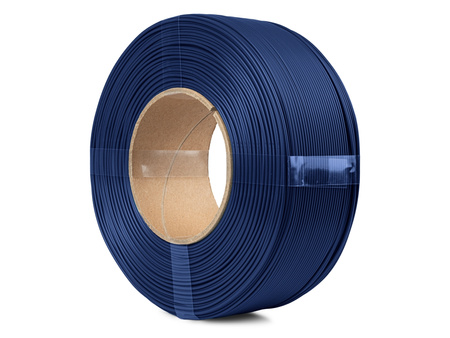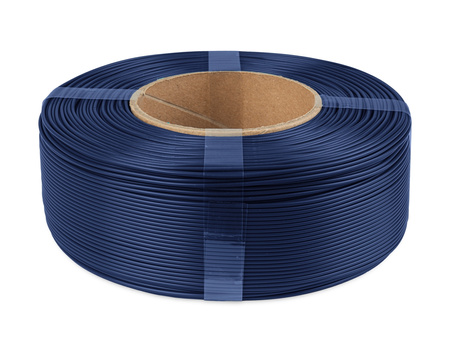ReFill LW-ASA UltraFoam 1.75mm NAVY BLUE 0.75kg
- Spectrum LW-ASA UltraFoam is a professional technical filament that combines the excellent UV and weather resistance of ASA with advanced active foaming technology.
Filament Spectrum LW-ASA UltraFoam
Spectrum LW-ASA UltraFoam is a professional technical filament that combines the excellent UV and weather resistance of ASA with advanced active foaming technology. Thanks to the unique properties of the material, it enables up to 3x weight reduction of printed parts without compromising strength or surface quality. LW-ASA UltraFoam is an ideal solution for users seeking lightweight, durable, and visually appealing prints for outdoor and technical applications where weight and efficiency matter.
The filament is based on the proven Spectrum ASA 275 formula, enriched with additives that enable controlled expansion during printing. The foaming process activates at around 230°C, with the maximum effect achieved in the range of 270°C–285°C. When printed below 230°C, the material behaves like standard ASA 275, giving users great flexibility in tuning print settings.
In its fully foamed state, the filament expands up to three times its original volume, achieving an extremely low density of approximately 0.33 g/cm³. LW-ASA UltraFoam gives the user exceptional control over material flow, allowing it to be reduced by up to 66%. The degree and speed of foaming can be precisely adjusted by changing the printing temperature, which makes it possible to customize the density of specific parts as needed. The foaming effect also supports faster 3D printing, by enabling thicker layer heights or solid single-wall outlines.
Using Spectrum LW-ASA UltraFoam, it’s possible to achieve significant weight reductions of printed parts – up to 34% compared to traditional ASA, and even up to 3x in extreme cases.
The matte and rough surface finish effectively hides layer lines, giving the final part a professional look. The foaming degree also influences the shade of the material – as expansion increases, the filament color may become visibly lighter. Additionally, the filament retains all key ASA features – high UV resistance, dimensional stability, and mechanical durability. It’s a perfect choice for projects where every gram counts, such as RC modeling, drone structures, or lightweight functional components.
Key Features:
- Over 3x weight reduction of printed parts
- Active foaming technology – activated at 230–285°C
- Adjustable material density – full control over flow and part structure
- Low final density – as low as approx. 0.33 g/cm³
- Over 3x more yield – one spool of LW-ASA UltraFoam can print as much as three spools of standard ASA
- UV and weather resistant – ideal for outdoor applications
- Matte finish hides layer lines
Tips:
- Foaming level may vary depending on printer model (e.g., Bambulab P1S/X1C achieved 0.33 flow, Prusa i3 MK3S – 0.42)
- Higher foaming level can be achieved in enclosed-chamber printers
- Moisture negatively impacts foaming – drying the filament before use is recommended
- Increasing retraction helps reduce artifacts and stringing; remaining imperfections can be easily removed manually
- If the model sticks too much to the bed – lower bed temperature, clean the surface, or use an adhesive aid
- If the model comes out too brittle, the flow is too low – increase value of the flow


280°C, 0.33 flow, 15mm/s, Bambulab P1S 230 °C, 1.01 flow, 200mm/s, Bambulab P1S
How it's working?
In order to obtain the maximum lightweight part, it is necessary to determine the expansion rate of the filament.
1. Print thin-wall test cube. Ensure the model has only one perimeter (vase mode). Test prints should be done in the 230°C–285°C range, preferably with 5°C intervals. Set the lowest possible fan speed (0–10%). Print speed should not exceed 15 mm/s. Significantly lower acceleration and travel speed. Dry the filament before use.

2. Measure the wall thickness of each test model and choose the temperature at which the wall is thickest.

3. Then, for the temperature determined in step 2, print calibration cubes, gradually reducing the flow value so that the wall thickness equals the nozzle diameter. Typically, the flow should be somewhere between 28-40%.

4. Finally, print your target model and check if the print is successful. You may need to fine-tune the flow – usually within a few percentage points of the value obtained in step 3.
Check the technical data sheet and product data sheet
| Content [g] | Width [mm] | Outer diameter [mm] | Inner diameter [mm] | Weight empty [g] | Material | Spool color |
|---|---|---|---|---|---|---|
| 250 | 44 | 140 | 52 | 120 | Plastic | Transparent |
| 250 | 44 | 140 | 52 | 80 | Cardboard | - |
| 500 | 55 | 200 | 52 | 240 | Plastic | Transparent |
| 750 | 55 | 200 | 52 | 240 | Plastic | Transparent |
| 1000 | 67 | 200 | 52 | 260 | Plastic | Transparent |
| 1000 | 67 | 200 | 52 | 180 | Cardboard | - |
| 2000 | 100 | 300 | 52 | 600 | Plastic | Black |
| 2000 | 100 | 300 | 52 | 420 | Cardboard | - |
| 4500 | 100 | 350 | 52 | 780 | Plastic | Black |
| 8000 | 167 | 355 | 36 | 1020 | Plastic | Black |
Each spool is sealed. We recommend storing filaments in a cool (15-25°C) and dry place.





